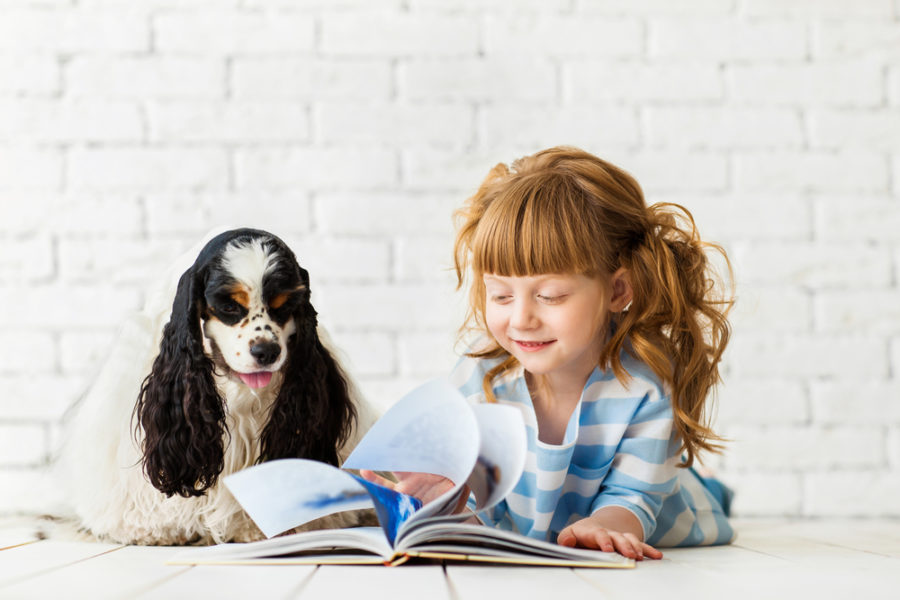Take a look at how dogs and cats are helping kids learn to read.
In our age of computer games and smartphones, getting kids to pick up a book and read can be almost impossible. But that may be changing, thanks to a proliferation of literacy programs that pair kids with dogs and cats as reading buddies.
The concept of improving a child’s literacy skills by having him or her read aloud to a dog or cat isn’t new. Animal Assisted Reading Programs and Reading Education Assistance Dogs (READ) are both international literacy programs that have been applied throughout the US and Canada for some years now. More and more of these programs are springing up across the country under a variety of names. For example, in California the program is called Paws for Tales. In Washington, it’s Reading with Rover, and in Pennsylvania, Book Buddies. The largest is the Intermountain Therapy Animals Association, based in Utah.
How it works
Dogs are chosen for reading programs more often than cats, for the simple reason that dogs are easier to train. Interested individuals volunteer themselves and their dogs as mentor teams, and are screened and trained by the organization. Dogs must be gentle and well-behaved in order to be paired with a child, and need to be at ease with strange people, noises and smells. Every mentor team is tested for their physical, emotional and mental skills. Mentors also have to be insured.
The programs work with local schools, libraries or bookstores that offer space for animal assisted reading activities. Children and dogs enrolled in the program go to these locations at set times to spend supervised reading time together.
Some programs utilize cats as reading partners for children. For example, cats have proven more soothing than dogs for children involved in the Book Buddies reading program in Pennsylvania. Children aged six to 13 visit the Berks County Rescue League to interact with and read to the homeless cats at the shelter. A reward system has been implemented for children who read a certain number of books, encouraging them to read more while also providing extra companionship to the cats – a win-win situation.
Animals are good listeners
You may be wondering how reading to a dog or cat can improve a child’s literacy skills. According to educator Dr. Lori Friesen, author of How Your Dog Can Help your Child, Read, Lead and Succeed, animals can assist kids in “a number of areas such as communication, self confidence, risk taking, creativity, playfulness, motivation, unconditional acceptance, companionship and individual learning.”
When it comes to reading aloud, animals provide children with a responsive audience that is non-judgmental and non-threatening, thereby helping kids feel more confident and relaxed. Dr. Friesen says ongoing research has revealed that dogs in particular provide interactive feedback to a child reading aloud, by wagging their tails, cocking their heads, or using other forms of body language.
Pascal Belin, meanwhile, a neuroscientist at the University of Glasgow, has found that “dogs process voices in the same way that human brains do”. A well-trained dog displays curiosity, friendliness and patience when listening to someone talk, a trait that helps children who are learning to read sound out words without fear of being judged. While the animal doesn’t understand what’s being read, he responds to the child’s voice in a way that makes the youngster feel at ease.
Cats also make good reading buddies. According to a study from The University of Tokyo, cats respond to human voices by moving their heads or ears towards the source of the voice. Well-socialized cats respond in visibly positive ways to the sound of someone speaking, through attentiveness and displays of affection such as purring, head-butting, and jumping into laps.
Research shows positive results
According to a 2010 study conducted by the University of California, children who read to animals for 15 to 20 minutes once a week for eight weeks increased their reading skills by 12% to 20%. Teachers who were part of the study took notes to identify changes in the classroom behavior of these young readers. They reported that the students who took part in the study exhibited improved self confidence and participated more in class.
Create a book nook
If you have children or grandchildren, as well as a kid-friendly dog or cat, you can create your own animal assisted reading program at home. You’ll first need to ensure that the child and animal have a positive, mutually respectful relationship, and that they enjoy spending time in one another’s company.
Set aside a quiet spot where both the child and animal feel comfortable and at ease. It could be a sofa, windowseat, a corner of the child’s bedroom, or even a temporary pillowfort. Keep a basket of age-appropriate reading material on hand, and encourage the child to read to the dog or cat whenever both are comfortably established in this area. A few healthy treats for the animal will help reinforce the idea that time spent with the child in the reading nook is a positive experience.
While animal assisted reading programs may not work for every child, they’re proving effective for those who are a good fit. Just another wonderful example of how animals enrich our lives!







